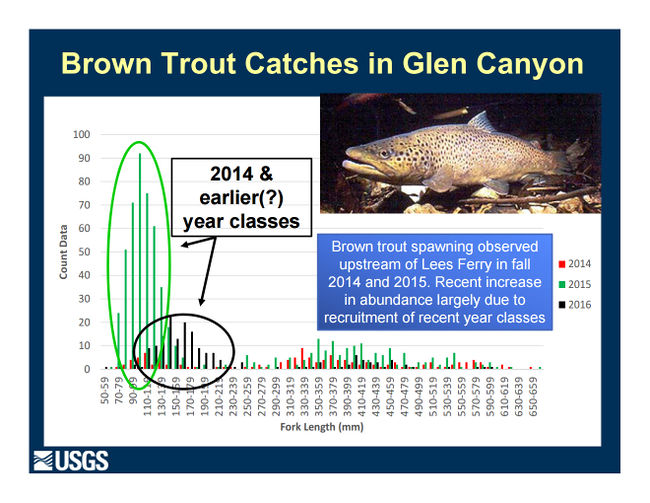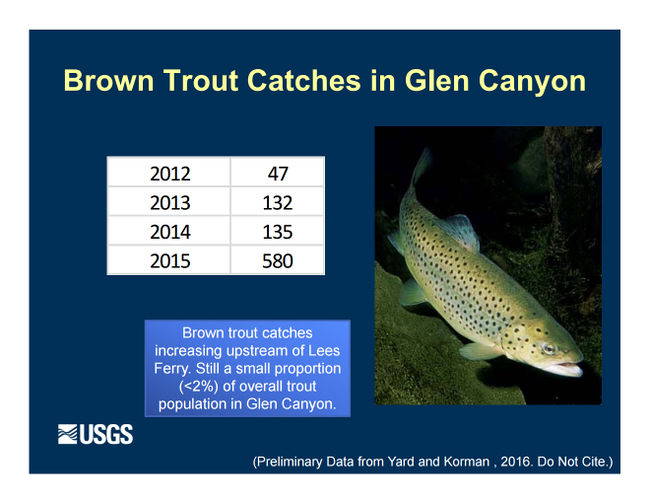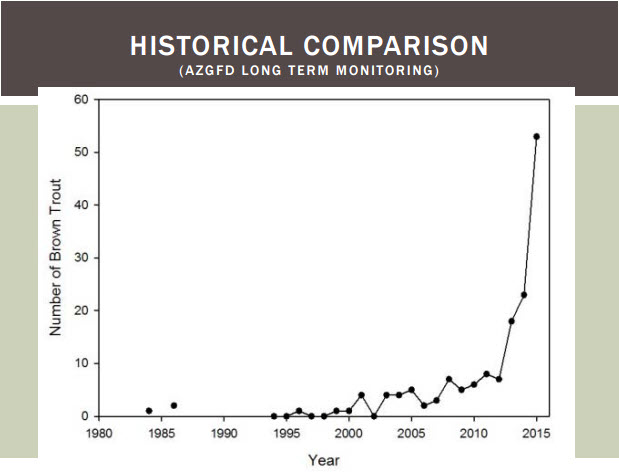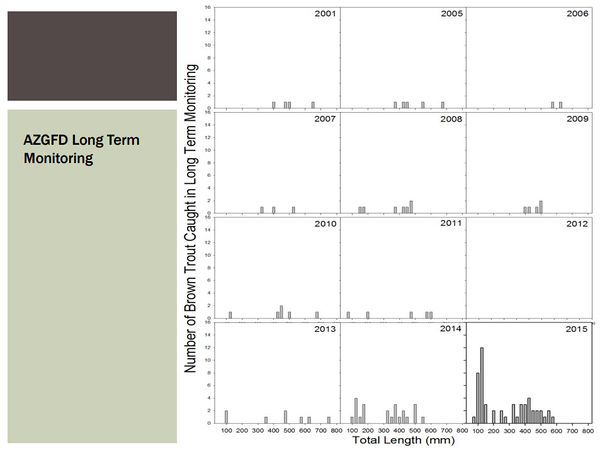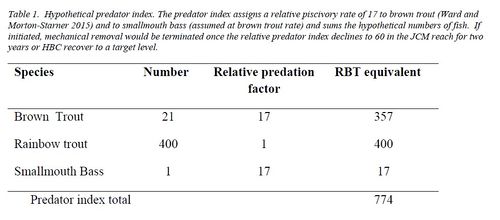Updates
|
[6]
[7]
[8]
[9]
 Brown trout are much more likely to eat other fish (piscivory) but since there are many more rainbow trout in the Colorado River between Glen and Marble Canyons, rainbow trout probably eat more fish numerically than brown trout. [1]
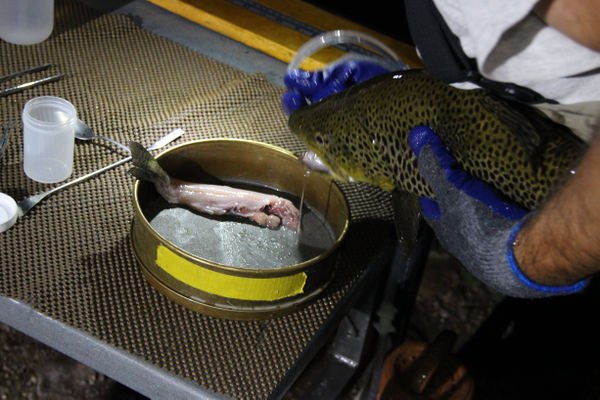 An increasing brown trout population in Glen Canyon could pose a problem for both the Lees Ferry rainbow trout fishery and native fish in Grand Canyon because brown trout eat both rainbow trout and native fish alike. Above is a photo of a brown trout collected during 2016 trout monitoring below Flaming Gorge dam that had just eaten a 10" stocked rainbow trout. |
|
Information and Links
|
|
|
Projects
|
|
|
|
|
Action requested. Proposed draft motion AMWG meeting 2/15/17:
The AMWG believes that before moving forward with any new actions to manage brown
trout in the Lees Ferry reach of the Colorado River, it would be beneficial to work to
develop a plan based on the most up to date information and that has involvement
from interested members of the AMWG. Accordingly, the AMWG requests that the
Secretary of the Interior direct the National Park Service, and request the Arizona Game and
Fish Department, to organize and facilitate a workshop among scientists, managers, tribes,
and interested stakeholders to address:
- The root causes of the increases in brown trout,
- The risks associated with an expanding brown trout population to a quality rainbow trout fishery in Lees Ferry and the recovery/conservation of humpback chub and other native fish down river,
- The pros and cons of different management options to address those risks, and
- The research needs to support more informed decisions moving forward.
The workshop should also review the efficacy of the current High Flow Experiment protocol in light of new
scientific information and how it could be modified to allow for more frequent Spring HFEs
to conserve sediment and enhance biological resources in the Colorado River below Glen
Canyon dam. Results from the workshop, and any recommended actions based on them,
should be reported to the TWG for consideration in development of the Triennial Work
Plan and presented to the AMWG at the August 2017 meeting.
|
Stakeholder Concerns
|
- the root causes of the increases in BT,
- the risks associated with an expanding BT population to a quality RBT fishery in Lees Ferry and the recovery/conservation of humpback chub and other native fish down river,
- the pros and cons of different management options to address those risks, and
- the research needs to support more informed decisions moving forward.
|
Presentations and Papers
|
|
2018
2017
2016
2015
2014
2013
2011
|
|
|
Tier 1 Trigger – Early Intervention Through Conservation Actions:
- 1a. If the combined point estimate for adult HBC (adults defined ≥200 mm) in the Colorado River mainstem LCR aggregation; RM 57-65.9) and Little Colorado River (LCR) falls below 9,000 as estimated by the currently accepted HBC population model (e.g., ASMR, multi-state).
-OR-
- 1b. If recruitment of sub-adult HBC (150-199mm) does not equal or exceed estimated adult mortality such that:
- Sub-adult abundance falls below a three-year running average of 1,250 fish in the spring LCR population estimates, or
- Sub-adult abundance falls below a three-year running average of 810 fish in the mainstem Juvenile Chub Monitoring reach (JCM annual fall population estimate; RM 63.45-65.2).
Tier 1 Trigger Response:
- Tier 1 conservation actions listed below will be immediately implemented either in the LCR or in the adjacent mainstem. Conservation actions will focus on increasing growth, survival and distribution of HBC in the LCR & LCR mainstem aggregation area.
Tier 2 Trigger - Reduce threat using mechanical removal if conservation actions in Tier 1 are insufficient to arrest a population decline:
Mechanical removal of nonnative aquatic predator will ensue:
- If the point abundance estimate of adult HBC decline to <7,000, as estimated by the currently accepted HBC population model.
Mechanical removal will terminate if:
- Predator index (described below) is depleted to less than 60 RBT/km for at least two years in the JCM reach and immigration rate is low (the long term feasibility of using immigration rates as a metric still needs to be assessed),
-OR-
- Adult HBC population estimates exceed 7,500 and recruitment of sub-adult chub exceed adult mortality for at least two years.
If immigration rate of predators into JCM reach is high, mechanical removal may need to continue. These triggers are intended to be adaptive based on ongoing and future research (e.g., Lees Ferry recruitment and emigration dynamics, effects of trout suppression flows, effects of Paria River turbidity inputs on predator survival and immigration rates, interactions between humpback chub and rainbow trout, other predation studies).
|
Other Stuff
|
- "The divergent responses of brown trout and rainbow trout populations to the summer flood could be explained by competitive interactions. Brown trout are autumn spawners, whereas rainbow trout are spring spawners, and thus, YOY brown trout emerge earlier, are larger and may outcompete YOY rainbow trout (Gatz, Sale & Loar, 1987; Strange et al., 1992 ). Conversely , the autumn spawning of brown trout increases the risk of egg loss if autumn or winter floods occur. Several investigations showed that YOY brown trout or brook trout were generally more numerous than YOY rainbow trout except during years when floods scoured the eggs of the autumn spawners (Seegrist & Gard, 1972; Strange et al., 1992; Warren et al., 2009 ). " [10]
|
|

